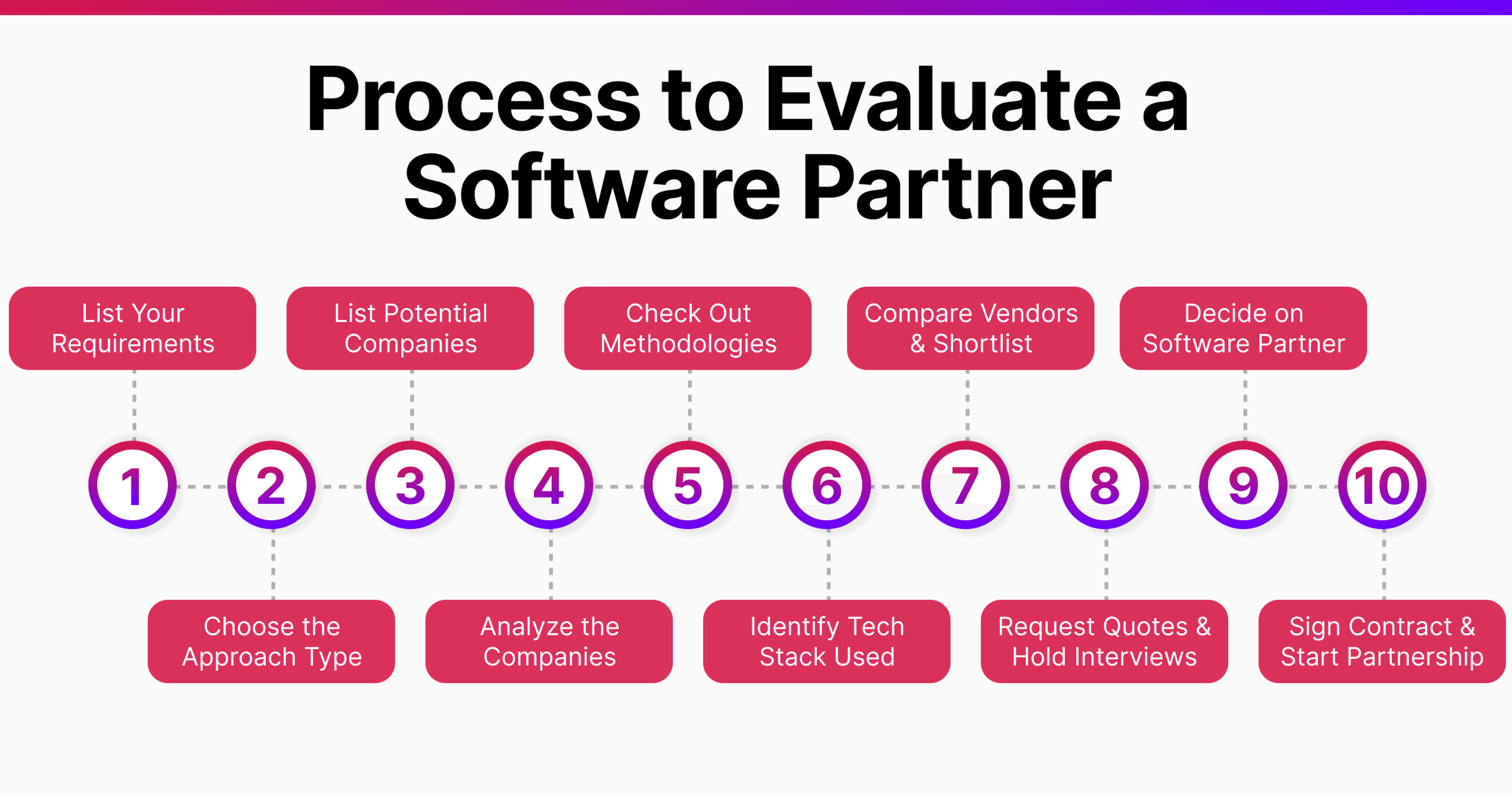When and How to Build Your Own Software with an External Software Development Partner
Dec 23, 2024
In today's world, the digital landscape is constantly evolving at a rapid pace. To keep up with the competitive market, businesses ought to innovate efficient software solutions.
One smart strategy for businesses is to work with an outside software development partner. This is especially true for teams in nearby countries. However, we should clarify that working with an external team requires effort. Building a partnership based on trust and mutual understanding regarding the goal requires commitment.
This blog article will subsequently explore the top 10 key learnings that will equip businesses with a competitive advantage. Businesses will be guided to understand when and how to effectively build a custom software with an external partner. By following these different insights, you will be better prepared to recognize the key factors in creating successful collaborations. Such essential elements will assist to drive your business forward.

1. Recognize When It’s Time to Bring in External Expertise
To build a successful partnership, you first need to understand that you require help. This help should come from an outside software development partner. Many companies start with the idea that everything can be handled in-house.
However as time passes, businesses will then realize that needing external expertise is not a sign of weakness. The fast pace of technology and growing customer demands will reveal the hidden gaps in our internal skills. This is due to the complexities of software development.
It is a strategic move to gain external resources and skills that are needed to achieve business goals. Internal teams often face challenges such as lack of knowledge, resources, and tight deadlines. In such cases, a partnership with an experienced external software development partner can provide the help needed to achieve business goals more efficiently.
Situations Where an External Partner Can Help:
- Need for Specialized Skills: You want to use new technologies like AI, blockchain, or cloud computing. However, you lack experts in your team.
- Resource Constraints: The internal team is fully occupied with core business tasks and are unable to take on other projects.
- Urgency and Scalability: You have a critical deadline or a need to scale urgently to meet market demands.
Working with a software development outsourcing partner can help you gain specialized knowledge. Your organization may not have this expertise on its own.
Advantages of External Expertise:
External partners have a broader talent pool, and more in depth knowledge in different niches such as DevOps, AI/ML, or IoT. They bring in fresh perspectives and tried-and-tested methodologies to execute projects more efficiently. External partners can act as an extension of your team. They offer flexibility to adjust resources based on project needs.
2. Define Clear Objectives and Requirements from the Start
Clearly defined objectives and requirements lay the foundation for a successful project. Without these crucial ingredients, you may risk miscommunication, scope creep, and missed deadlines. Establishing clear goals and expectations will assist your software development partner to understand your vision and align their efforts with your business needs.
Key Steps to Define Objectives:
- Identify Business Goals: What do you want the software to achieve? Examples include improving user experience, increasing sales, or automating manual processes.
- Specify Core Features: List out the must-have features and functions to guide the development process.
- Set Success Metrics: Decide on quantifiable indicators, such as conversion rates, user retention, or system uptime.
When you share this information with your partner, you set a solid foundation for the project and reduce the risk of misunderstandings.

Benefits of Clear Requirements
Clear requirements ensure that everyone is on the same page. They make it easier for your partner to provide accurate cost estimates, reduce the likelihood of project delays, and minimize the risk of costly revisions. Clear objectives also empower teams to make informed decisions when unforeseen challenges arise.
3. Why and How to Choose the Right Software Development Partner
Creating custom software is a big decision. It's usually better to work with a software development partner. This is often more effective than hiring freelancers or expanding your internal team. When taking on a software development project, one of the most crucial steps is knowing how to choose the right software development partner.
The optimal partner should have technical skills and knowledge. They should also meet other important criteria. This includes sharing your vision, understanding your industry, and communicating clearly and effectively. To choose the optimal partner, consider the following criteria:
Why Choose a Software Development Partner?
1. Expertise and Knowledge
A software development partner provides a team of skilled developers, designers, project managers, and testers. They work well together using effective operational and technical procedures. Freelancers usually work alone and may not have a wide range of skills. In contrast, a partner offers a flexible and complete approach to your project.
2. Scalability and Flexibility
Software development partners are able to quickly scale their teams in accordance with the project’s demands. This flexible approach helps tackle larger projects and adapt to the changing environment and requirements without the long term costs and time wasted through screening, of having to hire permanent employees.
3. Established Processes and Reliability
Experienced partners have frameworks, quality control measures, and project management practices. These proven processes lead to consistent results and better accountability in comparison to freelancers who most probably do not have the same structured approaches
4. Ongoing Support and Maintenance
A software development partner offers end-to-end services, post launch support, updates, and ongoing maintenance. This minimizes risk, and ensures that the software developed remains reliable and up-to-date, unlike freelancers who almost never provide these services.
How to Choose the Right Software Development Partner?
1. Technical and Industry Expertise
Ensure that the partner has experience and relevant technologies, and understands industry specific challenges and needs.
2. Cultural Fit and Communication
It is important to choose a partner whose work style, values, is in a similar time zone, and communicates transparently. It is also good to consider the personality of the potential members of the team.
3. Proven Track Record
It is a must to check client testimonials, case studies, and previous projects to assess reliability.
Why Cultural Fit Matter
A strong cultural fit ensures smoother communication and collaboration. When your software development partner shares similar values and work ethics, it reduces friction and misunderstandings. For example, if your company prioritizes transparency and open feedback, it’s essential to choose a partner with similar practices.

4. Establish Clear Milestones and Key Performance Indicators (KPIs)
As projects require attention-to-detail, consistency in its progress is key. Therefore, milestone indicators and KPIs should be established at the beginning stages.
For ease of convenience, milestones can be categorized into smaller segments. Hence, the project is able to identify its progress and any potential challenges easily. KPIs however have a different approach by producing transparent indicators of the project’s performance.
How to Set Milestones and KPIs:
- Divide the Project into Phases: Categorize the project into smaller divisions such as design, development, testing, and deployment.
- Define Specific Deliverables: Delegate deliverables to each milestone to maintain accountability.
- Set KPIs for Each Phase: Use metrics like code quality, bug resolution rates, and feature adoption rates to show progress.
Setting milestones and KPIs with the software development partner not only provides a common comprehension regarding the project’s progress, it also ensures that the timeline is being met.
Examples of Effective KPIs
Effective KPIs include user satisfaction scores, response times, feature adoption rates, and bug fix turnaround times.
5. Build Transparent and Open Communication Channels
A clear bridge of communication is crucial albeit internally or externally. Communication with external experts should always be transparent to connect a mutual understanding between two different teams. Hence, the external software development partner will be able to comprehend the needs of the project and align with its goals smoothly. Poor transparent communication often results in friction between the teams which causes delays in the project’s development.
Best Practices for Open Communication:
- Schedule Regular Meetings: Schedule consistent meetings between the teams to engage. Such engagement is to disclose the project’s progress and obstacles.
- Use Collaboration Tools: Communication tools like Slack, Teams, and Trello provide a platform to assist effective communication and collaboration.
- Designate Points of Contact: Delegate a role as a primary contact person amongst the teams to avoid miscommunications.
Transparent communication with your external partner not only allows you to ensure the project’s performance, it also creates a long-lasting relationship for future purposes.
Benefits of Transparency
The element of transparency within the teams’ communications allow information to be shared clearly and effectively. This essentially reduces the potential outcomes of project delays or failures. Furthermore, it allows the software development partner to have more inclusivity to the project.
6. Embrace Agile Methodologies for Flexibility and Adaptability
The agility of methodologies allows projects to transition itself pursuant to changing needs. Such flexibility offers an advantage by evolving projects swiftly based on new information or market conditions.
Why Agile Works Well with External Partners:
- Short Iterations: Shorter periods of development cycles reduces the time needed for potential adjustments.
- Continuous Improvement: Consistent sprint reviews allow both teams to magnify any areas where improvements are required.
- Collaborative Approach: Your internal team and your software development outsourcing partner are able to collaborate more effectively.
Frameworks including Scrum or Kanban assist businesses by assisting easier alignment between the teams for a smoother progress of the project.
7. Plan for Long-Term Collaboration and Future Growth
Prior to building a software, businesses should see a bigger picture as to whether such a software provides a long-term solution. Thus, it is crucial to foster a partnership between the internal and external teams as a long-term collaboration.
Strategies for Long-Term Success:
- Develop a Roadmap for Future Growth: A structure for upcoming additional features, updates, and improvements may be required as the development process progresses.
- Create a Maintenance and Support Agreement: Clarified terms regarding ongoing support, security updates, and new feature development should be informed.
- Conduct Regular Reviews: Structure regular reviews to share updated information regarding the project’s progress and manage your strategy accordingly.
Establishing a long-term planning strategy with your software development partner will allow you to maintain progress consistency.
Advantages of Long-Term Collaboration
Solid long-term partnerships give businesses the opportunity to establish a foundation of reliability amongst the teams. Due to the familiarity, onboarding time for new projects can be reduced.
8. Focus on Security and Compliance from the Start
The aspect of security should always be a priority for businesses. It is crucial that security and regulatory compliance should be clearly addressed and prioritized with the external software development partner at the initial stages. Industries that come across sensitive information such as healthcare or finance ought to take this into consideration.
Key Security Measures to Implement:
- Data Encryption: Sensitive information should be encrypted during transit and at rest.
- Access Controls: Restricting access to who can view and modify sensitive data.
- Compliance with Industry Standards: Clarify the significance of complying with respective industry regulations to your partner such as GDPR, HIPAA, or PCI-DSS.
As such, the risk of data breaches and legal complications can be reduced.
Benefits of Early Focus on Security
An early focus on security creates a strong trust between your business and your customers. Furthermore, it reduces chances of legal breaches and penalties.
9. Encourage Knowledge Sharing and Skill Development
Partnering with a custom software development partner provides businesses an opportunity to learn from external expertise. As such, internal teams are able to adopt new skill sets and knowledge into their work cultures.
Tips for Encouraging Knowledge Sharing:
- Organize Technical Workshops: Organize workshops where the external team shares their expertise for the internal teams to learn from.
- Implement Code Reviews: Scheduling code reviews where the external and internal teams collaborate.
- Document Key Processes: Structure a detailed report to record crucial information and decisions.
By means of encouraging a supportive momentum of continuous learning between the teams can allow your internal team to grow.
Why Knowledge Sharing Matters
A healthy bridge of sharing knowledge amongst the teams can guide the internal teams to grow. Such independence will allow them to have the expertise in order to tackle future projects.

10. Define Success Metrics and Measure Return on Investment (ROI)
As a last key factor, it is significant to clearly define success metrics for the project. This can effectively measure and track the progress and development of the project.
Common Success Metrics to Consider:
- Financial Metrics: Growth in revenue or reduction in expenses.
- User Engagement Metrics: Greater percentage of user satisfaction, increased retention rates, or improved adoption rates.
- Performance Metrics: Efficient system load times, lower error rates, or increased uptime.
Keeping track of ROI allows you to measure the value of your partnership and magnify potential space for improvement in future projects.
Importance of Measuring ROI
The clarity of success metrics guide teams to prioritize the project goals and objectives.
Conclusion
Fostering a healthy collaboration with an external software development partner provides a competitive advantage to businesses by allowing them to have the element of flexibility and scalability. The quick-paced digital transformation requires the utilization of external resources when needed. It should be acknowledged that partnerships with external teams require detailed planning along with strong commitment.
The above top 10 factors establish a notion for businesses to initiate a strong bond with the custom software development partner. Opting the right partner that aligns with your project visions pushes for better success and business growth.
Key Takeaway
Strategic collaboration with an external software development partner allows businesses to innovate their products according to the evolving market conditions. Businesses should comprehend when to seize the right opportunity in outsourcing external services effectively. Not only does this initiate the forward progress of the company, it also opens more opportunities within the competitive market.

Stefan Gligorov
Book a Free Consultation
Trusted by leading businesses worldwide
Book a Free Consultation
You may also like

Towards Perfect ES Query Generation with Elastic-builder
Apr 09, 2020
Velimir Graorkoski

Elastic Builder To The Rescue
Apr 22, 2020
Velimir Graorkoski

Understanding the Most Effective Practices of Remote Working
May 19, 2020
Tanja Zlatanovska